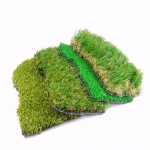The Showdown

Concern for the safety of athletes when playing sports on artificial turf began in the 1990’s; however, no clear comprehensive study of the effects of artificial turf on whole body injury risk in every sport involved has been complied thus far.

Additionally, studies that were performed years ago tested surface materials that are no longer used in artificial turf products, as companies are constantly improving their turf systems. Despite the growing popularity of artificial turf, researchers are concerned that artificial turf poses many injury risks to athletes including increased ACL and PCL tears, concussion rates, overheating surfaces, and skin infections.
The Research
The research has shown that materials used in synthetic turf do increase the risk of lower extremity injury for athletes involved in heavy lower limb loading sports like soccer and football. Synthetic surfaces do not allow a player to pivot or remove a layer of the turf system under shearing forces like natural grass can.

This increases the risk that the athlete’s cleat will not release from the turf under pressure and can overload their lower extremities, resulting in injury. Research has shown an increase in ACL and PCL tears for players using turf as opposed to natural grass especially during competitive play.
Additionally, researchers are concerned that artificial turf systems may lead to an increase in head injuries like concussion due to the surface hardness of the material under high heat. Although most concussions are attributed to collisions between players, around 20% of concussions occur when the athlete’s head collides with the ground.
The risk of a head injury depends on many factors like the acceleration of the head, direction of force, and magnitude of force, but the toughness of the surface coming into contact with the players head is a main contributor to injury.

Furthermore, researchers are studying the materials in the synthetic turf that overheat in the hopes to prevent that issue by inventing new products.
Application of water through an irrigation system of the use of different colored crumb rubber materials may assist in reducing the temperature of the turf to prevent burns and decrease the hardness of the turf during competition.
Researchers are also concerned that artificial turf is more abrasion-prone than natural grass and more likely to host microorganisms resulting in skin infections. As turf companies continue to improve their products, turf is becoming safer but still poses an increased risk of abrasions than natural grass.
Fortunately, studies determine that there is less total microbe load on synthetic turf when treated appropriately by maintenance facilities. Therefore, there is hope that the abrasive and ineffective nature of the turf can be combated.

In sum, modern turf needs to be continually tested and understood by researchers, athletic trainers, and other medical personnel as the technology continues to gain popularity in sports. Although some research has shown that artificial turf poses increased risk to athletes in comparison to natural grass, new products are being invented constantly to increase the safety of turf and minimize the injury risk to athletes.
Written by: Caleb Garde, ATC
Sources:
https://www.ncbi.nlm.nih.gov/pubmed/30096021

